The best edible amanitas
2 years ago · Updated 6 months ago
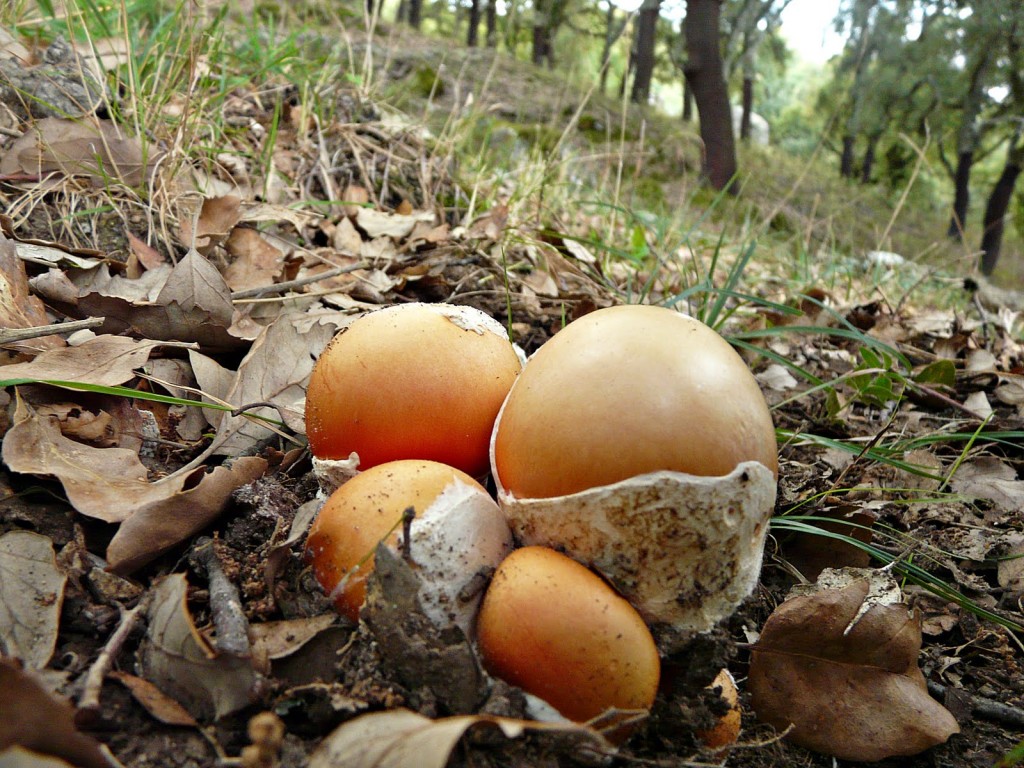
Amanita mushrooms are synonymous with toxic and poisonous mushrooms
In our mushroom blog, we have already discussed other edible and toxic species, so that you can learn mycology in a visual way. Using images and photographs of mushrooms is the best way to learn how to distinguish between poisonous or deadly species and edible species.
Amanita, synonymous with poisonous mushrooms... or not
When we talk about poisonous mushrooms or toxic mushrooms, the first genus that comes to mind is amanita. This is not surprising, as it includes some of the most dangerous deadly poisonous mushroom species, and undoubtedly those that cause the most incidents throughout the mushroom season.
Poisonous amanita mushrooms, the culprits behind most cases of poisoning
In fact, between 80 and 90% of cases of poisoning that occur season after season following the ingestion of poisonous mushrooms are due to the consumption of amanita mushrooms, mainly Amanita phalloides and Amanita pantherina.
Hence the importance of knowing the differences between poisonous and edible amanitas and their main characteristics.
This knowledge should be the first thing acquired by new mycology enthusiasts.
Amanitas. Not all are poisonous
But not all amanitas are poisonous! Far from it. This genus of fungi includes some of the most prized edible mushroom species in cooking and certainly the most sought after by mushroom and fungus hunters.
If you are interested in mycology and would like to learn about the different species of mushrooms, we recommend this illustrated mushroom atlas, which is very comprehensive and reasonably priced
The best edible amanitas
Among the more than 600 species included in this genus, there are many that are not only delicious in cooking but have also been traditionally harvested in many regions of our geography. In fact, Amanita caesarea is known as the queen of mushrooms for its delicate flavor and fine texture.
What are the 14 best edible amanitas?
It is difficult to choose from among the large number of edible amanitas, so we have selected those that are most renowned and widely consumed. We have classified them according to their culinary quality, ranging from excellent edible to those of normal culinary value. We therefore begin our ranking of edible amanitas
Amanita caesarea
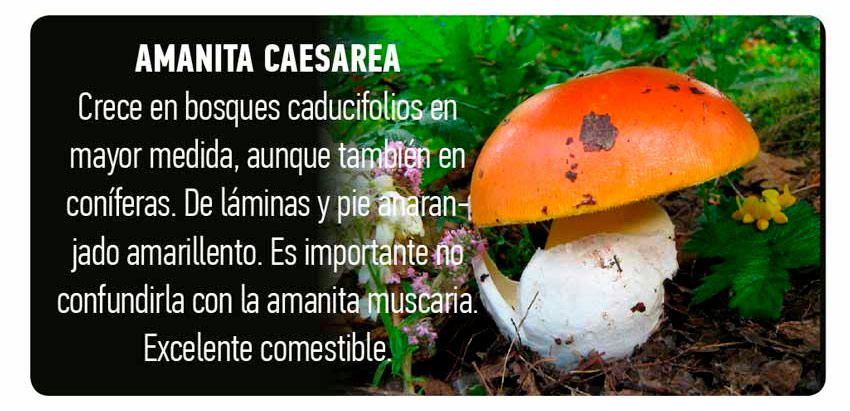
The queen of mushrooms and edible amanitas. There is written evidence of its widespread consumption since Roman times, which is why it is known as Caesar's mushroom. It grows mainly in deciduous forests, but also in conifers. It has yellowish-orange gills and stem. It is important not to confuse it with the fly agaric, which has white gills and stem. Excellent edible mushroom.
Amanita ponderosa
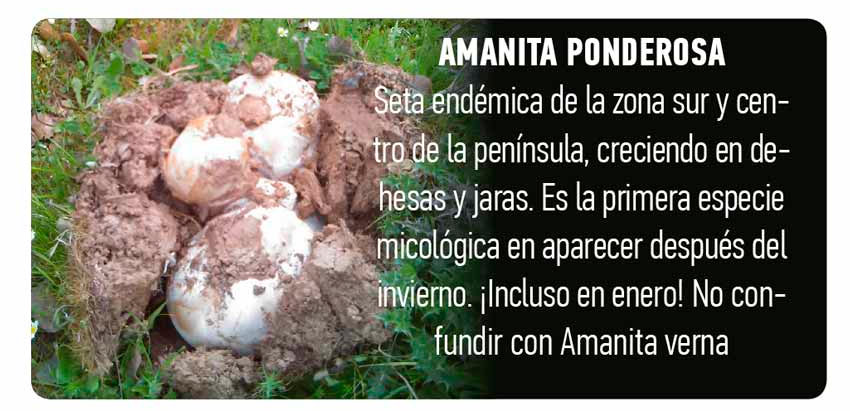
A characteristic mushroom endemic to the southern and central areas of the peninsula, growing in dehesas and cistus scrubland. It is the first mycological species to appear after winter, even in January. Excellent edible, it is highly prized in the areas where it grows. It grows underground, so a special tool is needed to harvest it. Do not confuse it with the dangerous Amanita verna
Amanita rubescens
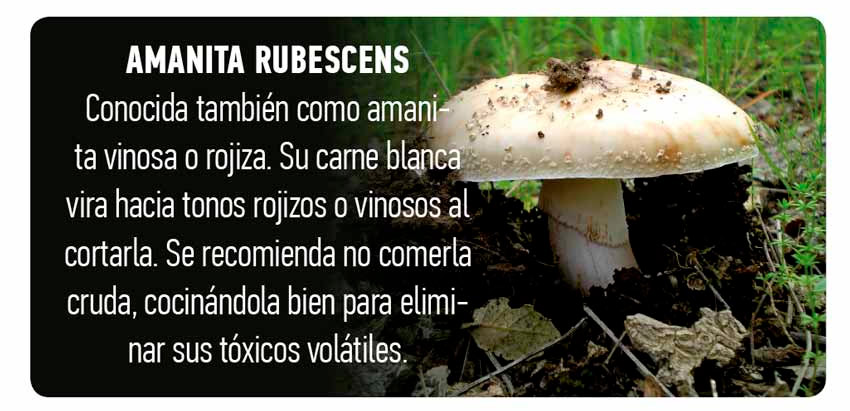
Also known as the wine-red or reddish amanita, this is one of the most popular edible amanitas. Its white flesh turns reddish or wine-red when cut. It has a pleasant mushroom aroma and a mild flavor. It grows in all types of soil and forests, making it very common. Although excellent for eating, it is recommended not to consume it raw, but to cook it thoroughly to eliminate its volatile toxins.
Amanita jacksonii
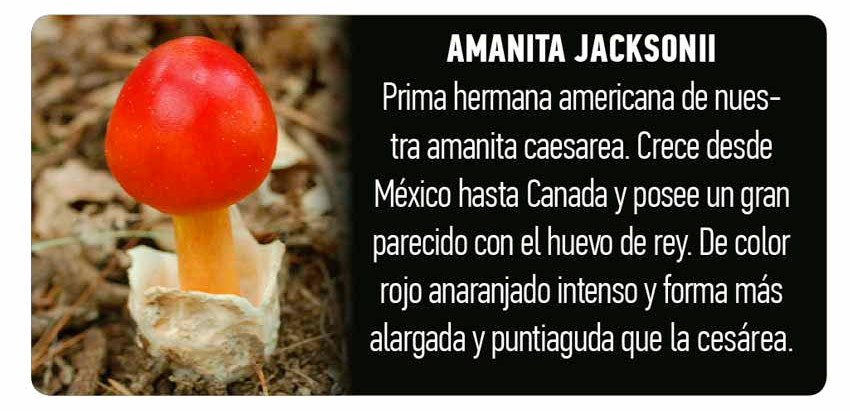
This is the American cousin of our Caesar's mushroom. It grows from Mexico to Canada and looks very similar to the Caesar's mushroom. It is bright orange-red in color and more elongated and pointed than the Caesar's mushroom. It also has a volva and is considered a delicacy.
Amanita mairei
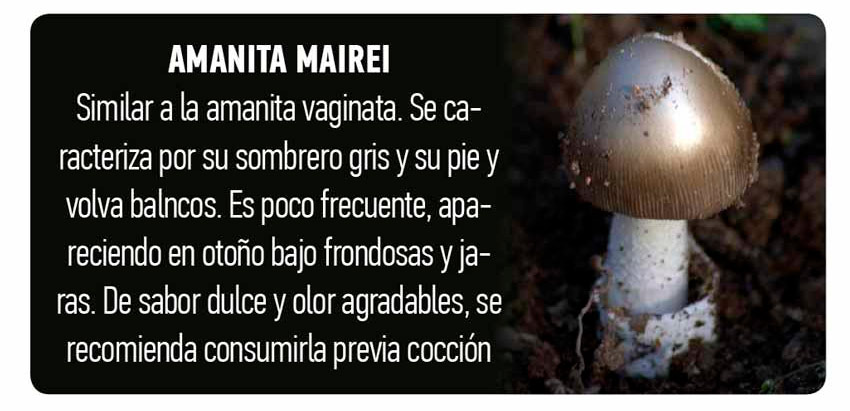
Similar to the amanita vaginata. It is characterized by its gray cap and white stem and volva. It is rare, appearing in autumn under deciduous trees and rockroses. It is edible, with a mild flavor and pleasant smell, although it is recommended to cook it before eating.
Amanita vaginata
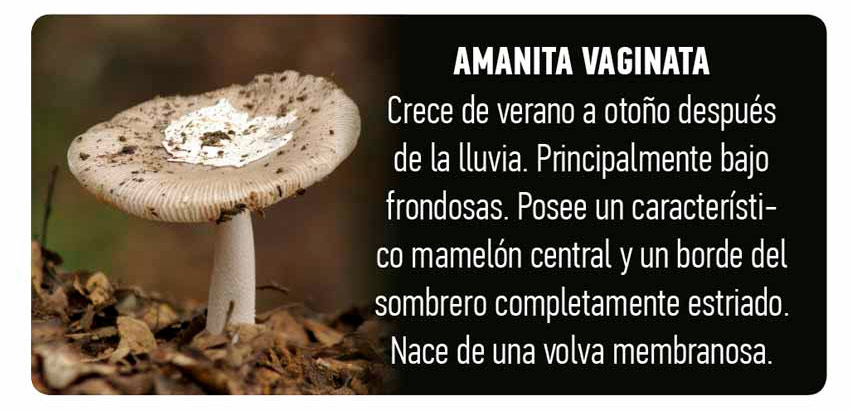
It grows from summer to fall after rain, mainly under deciduous trees. It has a characteristic central nipple and a completely striated cap edge. It emerges from a membranous volva. It is considered edible, although it must be cooked thoroughly to eliminate toxins.
Amanita baccata
With a mild, pleasant flavor, this is a thermophilic species common in spring and fall, growing on sandy soils, mainly under holm oaks. The cap and gills are creamy white. It is not recommended to pick this mushroom due to its close resemblance to other poisonous amanitas such as Amanita verna
Amanita boudieri
A Mediterranean species that prefers sandy soils, pastures, and rockroses. It grows very deep underground. It is characterized by its napiform stem, pointed volva, and polygonal, warty scales on its cap. It is very similar to Amanita verna, with which it shares its habitat, so picking it is restricted to expert mycologists
Amanita crocea
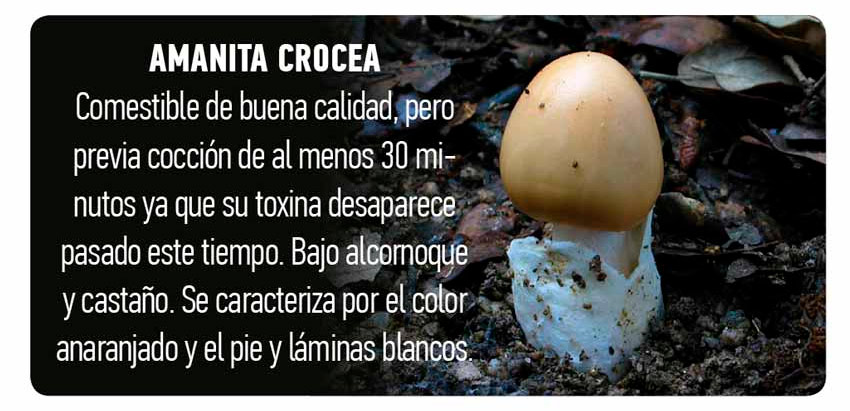
Edible and of good quality, but must be cooked for at least 30 minutes as its toxin disappears after this time. Found under cork oak and chestnut trees. Cylindrical stem, without ring and with a membranous volva. It is characterized by its orange color and white stem and gills. Known as the “lackey mushroom” in contrast to the golden agaric (Caesar's mushroom).
Amanita fulva
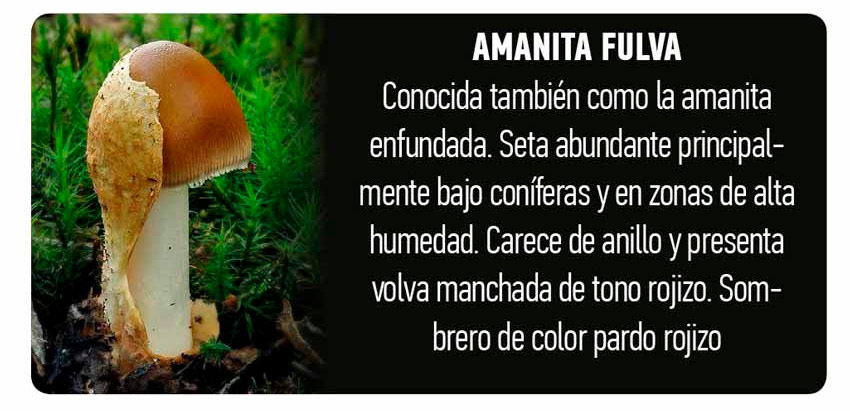
Also known as the sheathed amanita. A mushroom that grows abundantly mainly under conifers and in areas with high humidity. Mild taste and barely perceptible odor. It must be cooked before consumption, as it is poisonous when raw. It has no ring and a reddish-spotted volva. The cap is reddish-brown in color.
Amanita ovoidea
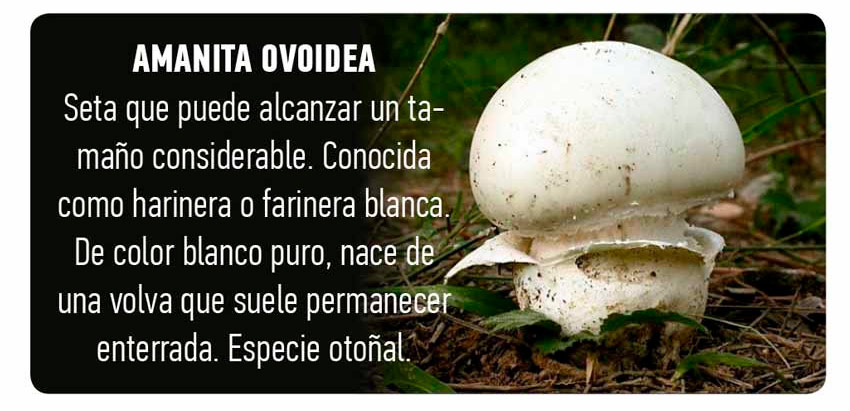
A mushroom that can grow to a considerable size. Known as the white flour mushroom. Pure white in color, it grows from a volva that usually remains buried. An autumn species that appears mainly in pine forests and along paths. It is considered edible, although of poor quality. Its close resemblance to other poisonous amanitas makes it inadvisable to pick.
Amanita strobiliformis or solitary
This species can grow to a considerable size. When young, it is whitish in color, turning gray when mature. The cap has wart-like remnants that may disappear with rain. It is edible but should be consumed with great caution. It is uncommon, thermophilic, and predominant in oak forests.
Amanita spissa
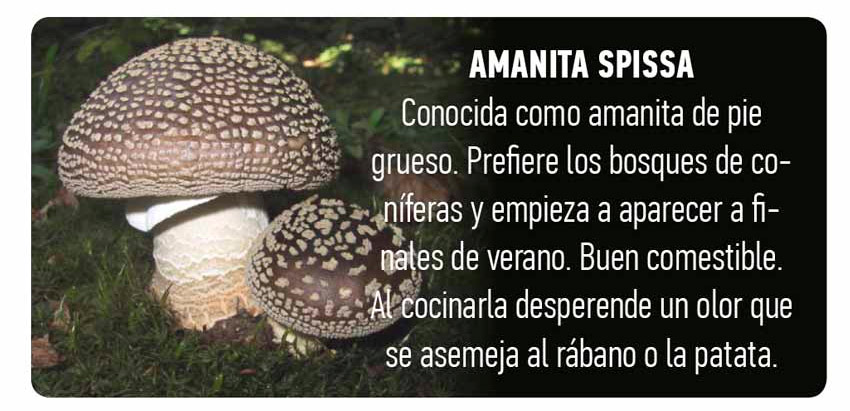
It is also known as the thick-stemmed amanita. It prefers coniferous forests to deciduous forests and begins to appear in late summer. It is edible when cooked and has a smell similar to radish or potato. It has a pleasant taste. It is important not to confuse it with the poisonous Amanita Pantherina, as they are quite similar
Are Amanita mushrooms edible? Yes, but they must be cooked thoroughly
There are many other varieties of Amanita mushrooms that are edible, although a common feature of almost all of them is the need for thorough and prolonged cooking. Many of them are toxic, but this disappears when cooked.
Dangerous similarities. Beware of confusion between Amanita mushrooms
Another fairly common characteristic of the aforementioned edible amanita mushrooms is their close resemblance to other toxic or even deadly varieties. At La Maison des Champignons, we recommend not picking them unless you are an expert mycologist and, above all, not eating any mushrooms that you are not 100% sure about.
If you pick another variety of amanita that you would like to tell us about, or if you have any comments on the ones we have presented in this post, please send them to us at our Facebook page. We will be happy to update and add to the information in this article.
Health and mushrooms!

Te pueden interesar